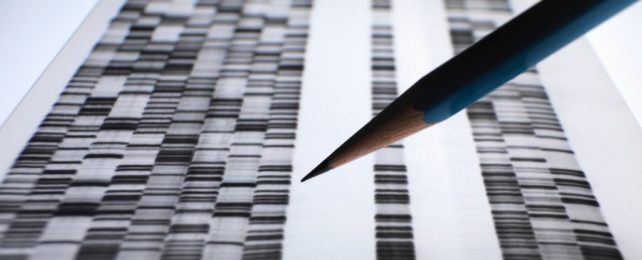Scattered among the genes passed down from long-gone relatives are scraps of the very viruses that attempted to hijack their bodies.
Hunting for signs of these long-gone invaders in our own bodies today could tell us a thing or two about disease. A new study has revealed a complication in this effort to understand the role of buried virus remnants in illnesses like cancer – their products appear in healthy tissues too.
Scientists estimate about 8 percent of a person's genome is made up of human endogenous retroviruses (HERVs). When alive and active, retroviruses have the ability to insert a template of their genome into the DNA of a host cell, adding to the set of genetic instructions that cell follows.
Many HERVs have since gone extinct, but bits of their genomes – while no longer adding up to an infectious virus – can still influence our biology to this day. For both good and bad.
If a viral insert makes it into the DNA of an ovum or sperm it can be copied throughout a new body, potentially passing down through successive generations for tens of millions of years.
These remnants are called proviruses, and the most recent ones integrated into the human genome belong to a subgroup of HERVs called HML-2. This subgroup was acquired by our primate ancestors about 35 million years ago, and fragments of its sequences are still found throughout the human genome.
Some proviruses acquired in the distant past now play a role in the formation of placenta during mammalian pregnancy. Others may block cellular receptors for active viruses today.
But not all the effects of HERVs are useful. Proviruses that are still intact enough to express protein-coding genes can get reactivated in the human body by autoimmune disease or cancer. The structural proteins of HML-2 proviruses are often found in high density in breast cancers, melanoma, and teratomas. In light of these findings, scientists have proposed using HML-2 expression as a biomarker for diseased tissue.
But a new study has found even healthy human tissue contains HML-2 expression.
"Despite the potential importance of HML-2-modified expression of viral or host genes, to date, HML-2 expression in a non-diseased human body has not been well characterized," researchers from Tufts University write.
"Data on HML-2 expression exist in various disease contexts, along with evidence of expression in some non-diseased tissues, but examination of all tissues in a host has yet to be performed."
To remedy that, researchers at Tufts analyzed 54 types of non-diseased tissue from 948 human donors. They found HML-2 transcripts in every single tissue type they analyzed, although some types contained more transcripts than others.
Levels of the proviral proteins were particularly high in the cerebellum, which sits at the back of the brain, and in the testes. In these tissues, 19 and 17 proviruses respectively were expressed.
The thyroid also contained a high number of proviral remnants, as did the pituitary gland, which is a bean-shaped structure in your brain that produces hormones.
Many of the proviruses identified by researchers in healthy tissue had been damaged by mutations or deletions over time. But some remained intact.
The functional consequences of this discovery are unclear, but the findings have important clinical implications nonetheless.
If HML-2 transcripts are to be used as a biomarker of disease, then they need to be measured against a background expression in healthy tissue as well. Otherwise, it might look like all tissue is diseased.
"We have found that nearly all normal human tissues express, in their RNA, one or another of about three dozen endogenous proviruses, remnants of widespread retrovirus infection of our distant ancestors," explains virologist John Coffin.
"We expect this finding to provide a basis for further studies to understand the role of these elements in human biology and disease."
The HML-2 group of HERVs is composed of numerous, closely related proviruses, but each one of these viruses is unique and may have acquired different mutations while in the human genome.
Researchers at Tufts are keen to explore the functional consequences of each, but it will require painstaking research.
Judging from the results of the current study, it seems older proviruses tend to be expressed in the human genome more. That suggests younger proviruses might have their expression suppressed, possibly because they present more of a threat.
Older proviruses have had more time to mutate and might even have contributed some biological advantages, which might have been selected for over time. But that's just an idea.
For now, the authors say the "role of HERVs in human biology is still largely a mystery."
The study was published in PLoS Biology.
